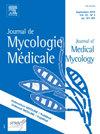特比萘芬耐药在两个意大利男男性接触者:一种新出现的性传播感染
IF 1.8
4区 医学
Q3 MYCOLOGY
引用次数: 0
摘要
我们报告,据我们所知,在一对意大利已婚男子(MSM)中观察到的头两例印度毛癣菌(T.)感染,可能是通过与来自印度的第三名男子的性接触获得的。这篇文章也提供了一个叙述性的审查,最近的现有文献对生殖器皮癣的潜在性传播。对于皮肤真菌病,性传播是一种推定诊断,但某些临床标准可能引起对性传播的怀疑,例如在有高风险性行为的个体中出现生殖器病变,脚和/或指甲未同时受损伤,无与受感染动物接触史,以及性伴侣中存在类似病变。近年来,一些报告表明生殖器皮肤真菌病的潜在性传播,主要由T. mentagrophytes基因型VII (TMVII)引起,首先在异性恋个体中观察到,然后在男男性接触者群体中也观察到,这表明在欧洲一级可能未被注意到的流行病。从2020年起,在全球30多个国家出现了与TMVII密切相关的新型菌株T. indotineae,但通常与特比萘芬耐药性有关。实验室鉴定需要先进的分子技术,因为基于培养的方法无法将T. indottineae与其他毛癣菌区分开来。适当的物种水平诊断对于确定适当的治疗方法至关重要。皮肤科医生应意识到这种新菌株的国际传播及其潜在的性传播,并在高危人群中进行有针对性的真菌学检测。本文章由计算机程序翻译,如有差异,请以英文原文为准。
Terbinafine-resistant Trichophyton indotineae in two Italian MSM: a new emerging sexually transmissible infection
We report, to the best of our knowledge, the first two cases of Trichophyton (T.) indotineae infection observed in a couple of Italian engaged men who have sex with men (MSM), potentially acquired through sexual contact with a third man from India.
This article also provides a narrative review of the most recent existing literature on the potential sexual transmission of genital dermatophytoses. For dermatophytosis sexual transmission is a presumptive diagnosis but some clinical criteria may raise suspicion of sexual transmission, such as the occurrence of genital lesions in individuals with high-risk sexual behavior, without simultaneous involvement of the feet and/or nails, without a history of contact with infected animals, and the presence of similar lesions in sexual partners.
In recent years, several reports have indicated a potential sexual transmission of genital dermatophytosis, mainly caused by T. mentagrophytes genotype VII (TMVII), first observed in heterosexual individuals and then also in groups of MSM, suggesting a potentially unnoticed epidemic at the European level. From 2020 onwards, the emergence of T. indotineae, a novel strain closely related to TMVII, yet often associated with Terbinafine resistance, has been documented in more than 30 countries worldwide. Laboratory identification requires advanced molecular techniques, as culture-based methods are unable to differentiate T. indotineae from other Trichophyton species. A proper species-level diagnosis is essential to establish the appropriate treatment. Dermatologists should be aware of the international spread of this new strain and its potential sexual transmission and conduct targeted mycological tests in at-risk populations.
求助全文
通过发布文献求助,成功后即可免费获取论文全文。
去求助
来源期刊
CiteScore
5.10
自引率
2.80%
发文量
68
审稿时长
6-12 weeks
期刊介绍:
The Journal de Mycologie Medicale / Journal of Medical Mycology (JMM) publishes in English works dealing with human and animal mycology. The subjects treated are focused in particular on clinical, diagnostic, epidemiological, immunological, medical, pathological, preventive or therapeutic aspects of mycoses. Also covered are basic aspects linked primarily with morphology (electronic and photonic microscopy), physiology, biochemistry, cellular and molecular biology, immunochemistry, genetics, taxonomy or phylogeny of pathogenic or opportunistic fungi and actinomycetes in humans or animals. Studies of natural products showing inhibitory activity against pathogenic fungi cannot be considered without chemical characterization and identification of the compounds responsible for the inhibitory activity.
JMM publishes (guest) editorials, original articles, reviews (and minireviews), case reports, technical notes, letters to the editor and information. Only clinical cases with real originality (new species, new clinical present action, new geographical localization, etc.), and fully documented (identification methods, results, etc.), will be considered.
Under no circumstances does the journal guarantee publication before the editorial board makes its final decision.
The journal is indexed in the main international databases and is accessible worldwide through the ScienceDirect and ClinicalKey platforms.

 求助内容:
求助内容: 应助结果提醒方式:
应助结果提醒方式:


